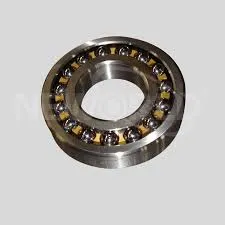
Dec . 11, 2024 11:30 Back to list
6206 bearing dimensions mm
Understanding 6206 Bearings Dimensions and Applications
Bearings are essential components in machinery, allowing for smooth movement and reducing friction between moving parts. Among the various types of bearings, the 6206 bearing is widely recognized for its versatility and efficiency in a range of applications. In this article, we will explore the dimensions of the 6206 bearing, its features, and its common uses in different industries.
Dimensions of the 6206 Bearing
The 6206 bearing is part of the 6200 series, which is characterized by its deep groove design. This design enables the bearing to accommodate both radial and axial loads, making it suitable for various applications. The standard dimensions for the 6206 bearing are as follows
1. Inner Diameter (ID) 30 mm 2. Outer Diameter (OD) 62 mm 3. Width/Thickness 16 mm
These dimensions are crucial for ensuring compatibility with specific shafts and housings in machinery. The standardized measurements mean that 6206 bearings can easily replace other bearings of the same dimensions, enhancing their utility in maintenance and repair scenarios.
Features of 6206 Bearings
One of the primary features of the 6206 bearing is its deep groove structure, which allows it to handle significant radial loads while also supporting limited axial loads in both directions. This design is conducive to high-speed applications due to the reduced friction between the rolling elements and the raceways. Moreover, the 6206 bearing is typically made from high-quality steel, which ensures durability and longevity.
Another notable feature of the 6206 bearing is its ability to operate effectively in various environments. Some variants are sealed or shielded to prevent contamination from dust and debris, making them suitable for use in harsh conditions. Additionally, 6206 bearings are available in different materials such as stainless steel, which provides corrosion resistance for applications where moisture is prevalent.
6206 bearing dimensions mm

Applications of 6206 Bearings
6206 bearings are ubiquitous in various industries due to their robust design and adaptability. Here are some common applications where these bearings play a critical role
1. Automotive Industry 6206 bearings are commonly used in electric motors, gearboxes, and wheel hubs, facilitating smooth operation in vehicles. Their ability to withstand high speeds and loads makes them a preferred choice in many automotive components.
2. Industrial Machinery Many types of machinery, including conveyor systems, pumps, and fans, utilize 6206 bearings. Their durability and reliability under continuous operation conditions contribute to the overall efficiency of industrial processes.
3. Home Appliances Products such as washing machines, refrigerators, and air conditioning units frequently incorporate 6206 bearings. Their role in these appliances is essential for the effective operation of mechanical movements.
4. Electric Motors 6206 bearings are extensively used in various electric motor applications, including servo motors and stepper motors. They allow for accurate motion control and contribute to the motor's overall performance.
5. Marine Applications In marine environments, where exposure to water and salt can affect equipment, 6206 bearings made from stainless steel can help mitigate corrosion, making them suitable for use in boats and other watercraft.
Conclusion
In summary, the 6206 bearing is a versatile and widely used component in many industries due to its optimal dimensions and features that enhance its performance in various applications. Understanding the specifications and applications of 6206 bearings is essential for engineers and technicians involved in design and maintenance. By choosing the right type of bearing for specific needs, industries can ensure smoother operations, reduce downtime, and achieve greater efficiency in their machinery. Whether in automotive, industrial, or consumer applications, the 6206 bearing's role cannot be understated, making it a staple in the world of engineering and manufacturing.
Latest news
-
Premium Deep Groove Ball Bearings | High Speed & Reliability
NewsAug.29,2025
-
Durable Scaffolding Clamps - Secure & Reliable Tube Connectors
NewsAug.28,2025
-
Common Failures in Thrust Ball Bearings and Solutions
NewsAug.22,2025
-
How Tapered Roller Bearings Can Take Shock Loads
NewsAug.22,2025
-
Angular Bearings in High-Precision Spindles
NewsAug.22,2025
-
The Impact of Misalignment on Cylindrical Roller Bearing Performance
NewsAug.22,2025
